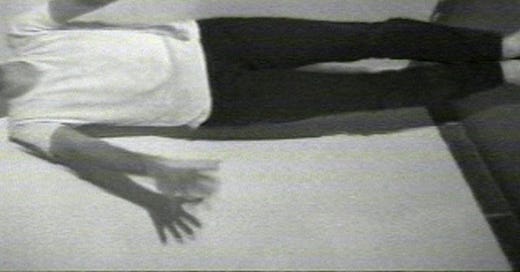Carlos Basualdo commissioned this essay on Bruce Nauman’s use of sound for the catalogue of an exhibition he co-curated. I wondered if I might be able to ask the artist a few questions, and Carlos, who knows Nauman well, said probably not, but graciously forwarded my request to Nauman’s studio assistant. The assistant wrote back: “I will show your questions to Bruce, however as we know, there may not be answers forthcoming.”
Given the warnings, I thought my best shot might be a single question, even better if I could reduce it to a single word. I wrote:
“I have a one word question for Bruce, I wonder if he might be willing to reply: ‘Foley?’”
After several weeks, an answer came back:
“Bruce does not understand ‘Foley.’”
For the following, I drew on the artist’s existing published interviews, combing through them for answers to my questions about his use of sound.
Originally published in Bruce Nauman: Contrapposto Studies, edited by Carlos Basualdo and Caroline Bourgeois (Marsilio Editori / Palazzo Grassi, 2021)
I cannot be alone in having heard Bruce Nauman’s work before I ever saw it. Many of his installations are loud. What is making that sound, I remember thinking at an exhibition that I eventually discovered included Clown Torture (1987). Did I go looking for it? Would you? “No no no no no no!” is hardly enticing. And yet, like an audio analogue to a car crash, we can’t look away from a sound like that. It must be coded into our genes that sounds of pain, fear, discomfort, warning, hostility, anger, and conflict are sounds whose source we seek out. Even if only to avoid them, we need to locate them.
Location is in fact among our primary biological uses of sound. We have two ears so that we can use sound for location: minute differences in volume and timing of sounds as they reach each side of our head enables us to locate their sources in space. This is also part of the process by which we determine our own location in space. It isn’t a skill we need to hone, through studies or time spent in art galleries and museums. It comes with the territory of being human.
And so a human being, in an art gallery or museum, will locate the sounds emanating from a Bruce Nauman exhibition. But what kind of location do they find themselves in, once they get there?
From his earliest works, represented in this exhibition by a suite of his now-classic video pieces from the 1960s, to the recent Contrapposto Studies, Nauman has used sound to dislocate the viewer in space. The Contrapposto Studies, with their dislocation of Nauman’s own body as its image is cut and reassembled, are among the most literal examples of this technique. But it can be traced throughout the many twists and turns of Nauman’s oeuvre, especially if one follows its sounds.


